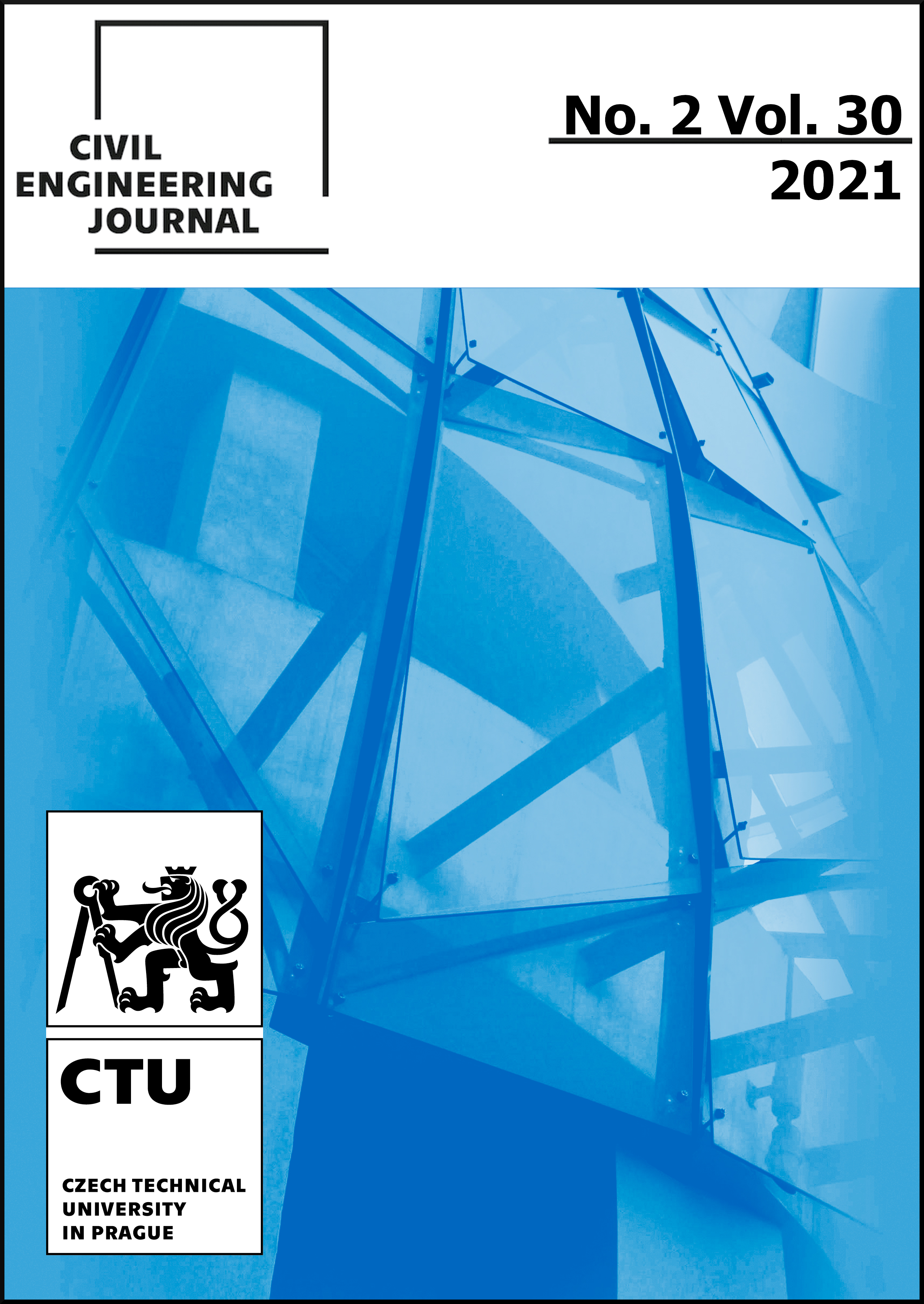EXPERIMENTAL STUDY ON THE RATE OF ABSORPTION OF WATER OF BASALT, POLYPROPYLENE, AND STEEL FIBERS REINFORCED CONCRETE
DOI:
https://doi.org/10.14311/CEJ.2021.02.0036Keywords:
Basalt fiber, Water absorption, Polypropylene fiber, Steel fiberAbstract
Good durability of concrete is an essential part of the design process, and tests to determine sustainability have been developed for both laboratory and site use. The main feature of durable concrete is low water absorption. Almost all forms of deterioration in reinforced concrete involve deleterious fluid ingress through the concretes pore structure. In wet concrete, the water ingress rate or other liquids is mostly controlled by absorption due to capillary rise. This study examines the effect of basalt, polypropylene, and steel fiber in different volume fractions at 0.3%, 0.6%, and 0.9% for absorption tests. A total of 8 specimens for different fiber were examined based on the rate of water absorption test recommended by ASTM C1585-04. A result obtained has been analyzed and compared with the control specimen. A relationship between absorption rate and the square root of time for both concrete mixtures was represented graphically and linearly. Result data showed a precise decrease in absorption due to incorporating both types of fiber. Also, from the result data, basalt and polypropylene showed greater uptake than steel fiber and enhances mass transport of water into concrete specimens. However, steel fiber addition showed high resistance to absorption rater than the control specimen and other fiber.
Downloads
References
M. Abdulhadi, A comparative Study of Basalt and Polypropylene Fibers Reinforced Concrete on Compressive and Tensile Behavior, Int. J. Eng. Trends Technol. 9 (2014) 295–300. https://doi.org/10.14445/22315381/ijett-v9p258.
R. Punyamurthy, D. Sampathkumar, R.P.G. Ranganagowda, B. Bennehalli, C. V Srinivasa, Mechanical properties of abaca fiber reinforced polypropylene composites: Effect of chemical treatment by benzene diazonium chloride, J. King Saud Univ. - Eng. Sci. 29 (2017) 289–294. https://doi.org/https://doi.org/10.1016/j.jksues.2015.10.004.
A.N.S. Al-Qadi, S.M. Al-Zaidyeen, Effect of fiber content and specimen shape on the residual strength of polypropylene fiber self-compacting concrete exposed to elevated temperatures, J. King Saud Univ. - Eng. Sci. 26 (2014) 33–39. https://doi.org/https://doi.org/10.1016/j.jksues.2012.12.002.
M.I. Khan, Y.M. Abbas, G. Fares, Review of high and ultrahigh performance cementitious composites incorporating various combinations of fibers and ultrafine, J. King Saud Univ. - Eng. Sci. 29 (2017) 339–347. https://doi.org/https://doi.org/10.1016/j.jksues.2017.03.006.
H. Prayuda, F. Monika, M. Dwi Cahyati, F. Saleh, Self Fiber Compacting Concrete (SFCC) Properties Incorporated With Silica Fume and Fiber, Stavební Obz. - Civ. Eng. J. 29 (2020) 52–60. https://doi.org/10.14311/cej.2020.01.0005.
M. Abdulhadi, M.S. Labbo, Comparative Study on the Effect of Sodium Chloride NaCl Solution as Curing Medium of Basalt, Polypropylene and Steel Fiber Reinforced Concrete on Compressive Strength, 6 (2016) 4750–4756. https://doi.org/10.4010/2016.1180.
M. İpek, Examination of the Usability of Basalt Aggregate in Sifcon, Stavební Obz. - Civ. Eng. J. 27 (2018) 500–512. https://doi.org/10.14311/cej.2018.04.0040.
Y. Zhang, Study on Anti-Cracking Performance Evaluation Method of Steel Fiber Reinforced Ceramsite Concrete (Sfrcc) Based on Partly-Restrained Shrinkage Ring, Stavební Obz. - Civ. Eng. J. 26 (2017) 394–403. https://doi.org/10.14311/cej.2017.04.0033.
B. Bhushan Jindal, P. Jangra, A. Garg, 2020. Effects of ultrafine slag as mineral admixture on the compressive strength, water absorption, and permeability of rice husk ash-based geopolymer concrete, Mater. Today Proc. vol. 32 871–877. doi.org/10.1016/j.matpr.2020.04.219.
J. a. Kropp, Performance criteria for concrete durability, n RILEM Report 12., London: E&FN Spon., 1995.
B.B. Sabir, S. Wild, M. O'Farrell, A water sorptivity test for mortar and concrete, Mater. Struct. 31 (1998) 568. https://doi.org/10.1007/BF02481540.
J. Castro, D. Bentz, J. Weiss, Effect of sample conditioning on the water absorption of concrete, Cem. Concr. Compos. 33 (2011) 805–813. https://doi.org/https://doi.org/10.1016/j.cemconcomp.2011.05.007.
R.J. Gummerson, C. Hall, W.D. Hoff, Water movement in porous building materials—II. Hydraulic suction and sorptivity of brick and other masonry materials, Build. Environ. 15 (1980) 101–108. https://doi.org/https://doi.org/10.1016/0360-1323(80)90015-3.
JGJ52-2006, Chinese National Standards, for technical requirements and test method of sand and crushed stone for ordinary concrete, n.d.
2011. JGJ55, Chinese National Standards. Specification for mix proportion design of Ordinary concrete, n.d.
A. C1585-04, Standard Test Method for Measurement of Rate of Absorption of Water by Hydraulic-Cement Concretes, ASTM Int. (2004).
Niveditha, M. and Srikanth, K. Effect of Durability properties on Geopolymer concrete – A Review E3S Web of Conference 184, 01092 (2020), ICMED 2020. https://doi.org/10.1051.e3sconf/202018401092
Downloads
Published
Issue
Section
License
Copyright (c) 2021 Author

This work is licensed under a Creative Commons Attribution-NonCommercial 4.0 International License.
Authors who publish with this journal agree to the following terms:
- Authors retain copyright and grant the journal right of first publication with the work simultaneously licensed under a Creative Commons Attribution License that allows others to share the work with an acknowledgement of the work's authorship and initial publication in this journal.
- Authors are able to enter into separate, additional contractual arrangements for the non-exclusive distribution of the journal's published version of the work (e.g., post it to an institutional repository or publish it in a book), with an acknowledgement of its initial publication in this journal.
- Authors are permitted and encouraged to post their work online (e.g., in institutional repositories or on their website) prior to and during the submission process, as it can lead to productive exchanges, as well as earlier and greater citation of published work (See The Effect of Open Access).
How to Cite
Accepted 2021-07-02
Published 2021-07-28











